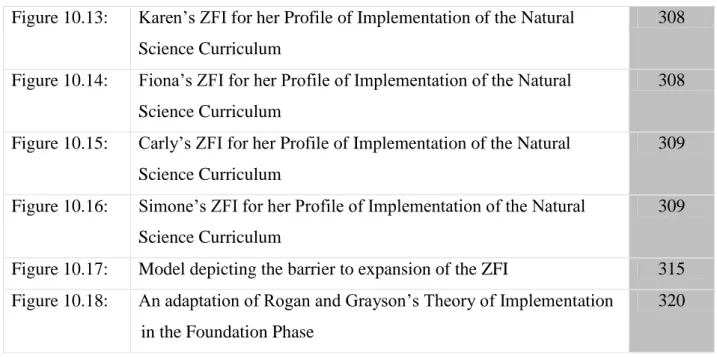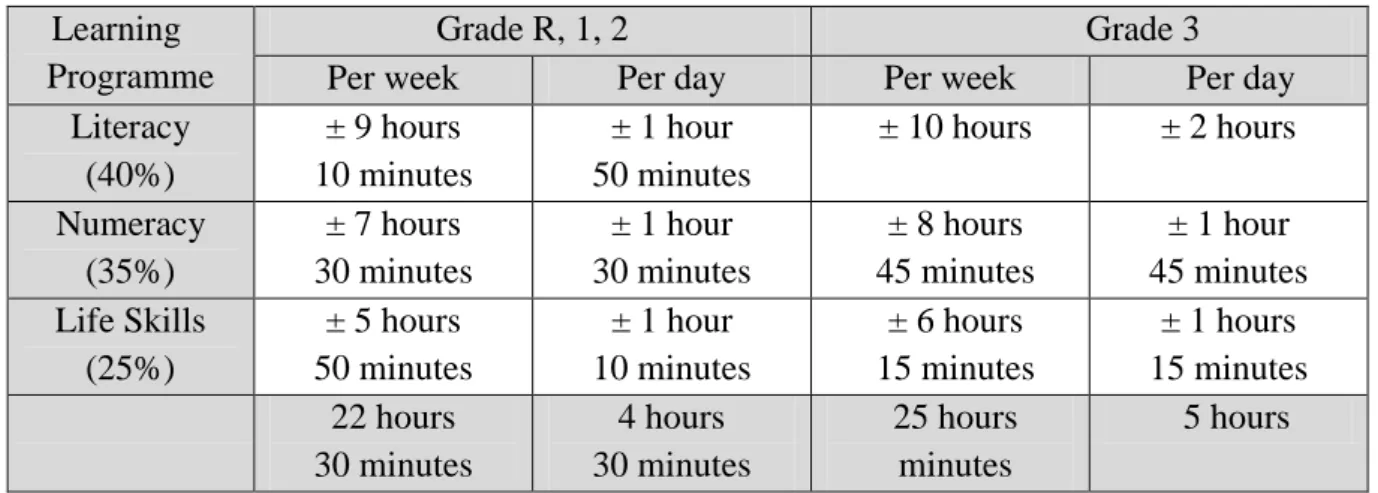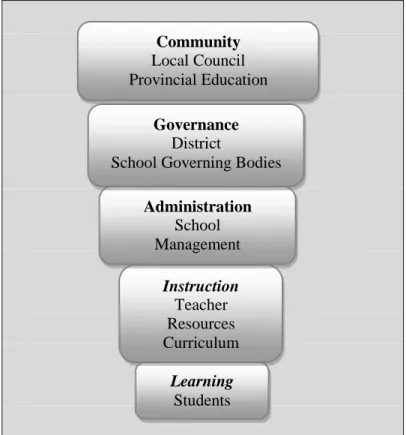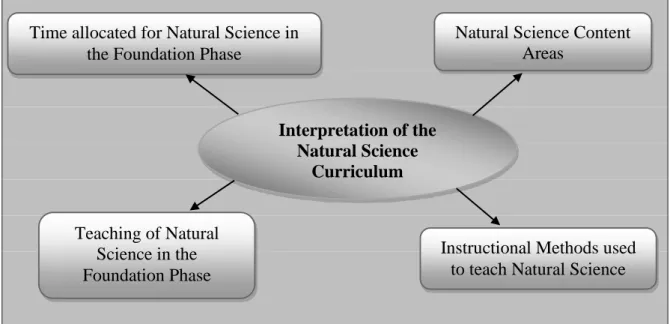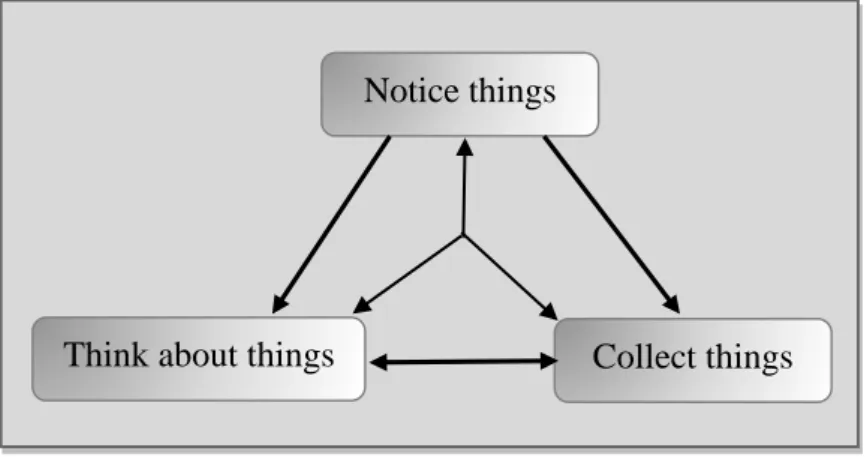6.3.2.2.5 Karen's level of implementation of the Science Curriculum in relation to her capacity to innovate. 7.3.2.2.5 Fiona's level of implementation of the Science Curriculum in relation to her Capacity to Innovate.
LIST OF TABLES
220 Table 8.2: Carly's interpretation of the science curriculum 237 Table 8.3: Carly's ability to implement the curriculum according to support.
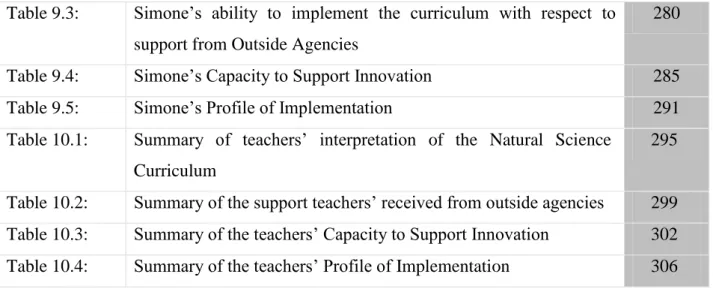
APPENDICES
ACRONYMS
CHAPTER ONE
SETTING THE SCENE
INTRODUCTION
BACKGROUND TO THE STUDY
The October 2009 report of the Ministerial Working Group on the Review of the Implementation of the RNCS contains several recommendations for improving the curriculum. Report of the Working Group to Review the Implementation of the National Curriculum Statement, 2009, p. 5).
THE FOUNDATION PHASE LANDSCAPE
- The Foundation Phase
- The Foundation Phase Teacher
- The Foundation Phase Learner
Department of Education, 2003a, p. 75) The student in the foundation stage is naturally curious and explores the world. According to the RNCS, the Foundation Stage Life Skills Learning Program includes the promotion of scientific literacy.
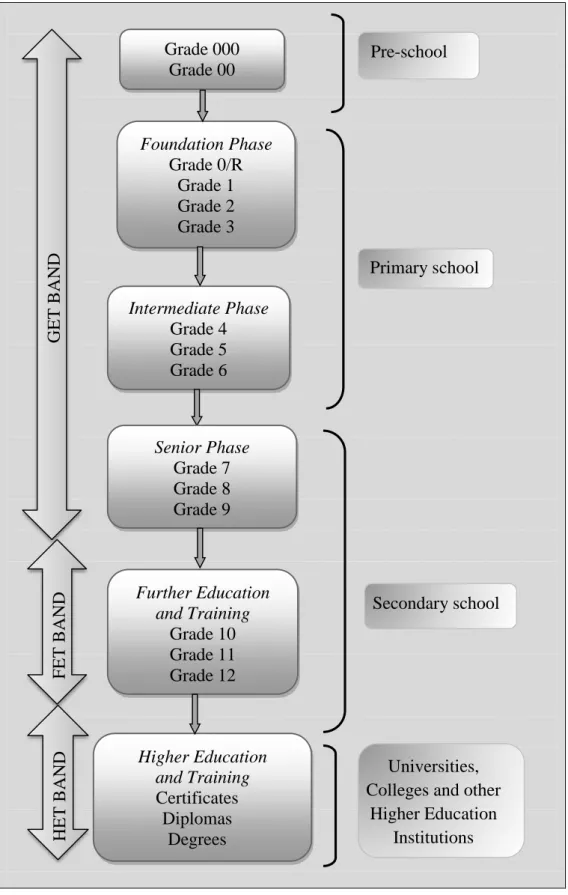
THE PURPOSE OF THE STUDY
Thus, although the RNCS is the context for the study, the focus of the study is on the ways in which teachers interpret and implement a science curriculum in the foundation phase. Although there are numerous studies on curriculum implementation in the education sector, this study is unique in that it focuses on the foundation phase and more specifically the science curriculum within the Life Skills Learning Program in the foundation phase.
PROBLEM STATEMENT
Why do Foundation Stage teachers interpret the Science curriculum in the way they do? Why do Foundation Stage teachers implement the Science curriculum in the way they do?
OUTLINE OF THE THESIS
My study therefore seeks to discover how pre-service teachers interpret and implement the science curriculum within the Life Skills programme. The main research question that frames my study is: How do preservice teachers interpret and implement the science curriculum within the Life Skills Learning program.
CONCLUSION
In chapters six, seven, eight, and nine, I present the findings as narratives based on data analysis of each teacher's interpretation and implementation of the curriculum. In chapter ten, I build on the findings presented in the previous chapters and relate the findings to existing literature in an attempt to answer the research questions.
CHAPTER TWO
LITERATURE REVIEW
INTRODUCTION
CURRICULUM
- Definitions of Curriculum
- Types of Curriculum
- Curriculum Theories
- Curriculum Models
- Curriculum in Action
The South African curriculum claims to be a manifestation of "the nation's social values and its expectations of the roles, rights and responsibilities of the democratic South African citizen as expressed in the Constitution" (Department of Education, 2003a, p. 5). In their study of two curriculum reform projects in Australia, they concluded: "The majority of teachers did not act as agents in the field of re-contextualization, although the potential to do so was present in each project" (Kirk & MacDonald, 2002, p. 564) .
SCIENCE EDUCATION
- Scientific Investigations
- Hands-on Science
As a result, the time spent teaching natural sciences in the foundation phase has been reduced. The ability to conduct scientific inquiry is the only learning outcome for science at the foundation stage; is an essential aspect of this study.
THE FOUNDATION PHASE
- The Foundation Phase Teacher
- The Foundation Phase Learner
This is confirmed in Waters-Adams' (2006) action research where four English primary school teachers understand the nature of science and their practice. This, combined with teachers' limited understanding of the curriculum, places teachers in a dominant role in the teaching and learning process. The Teacher's Guide to Developing Foundation Phase Curriculums provides a detailed description of the characteristics of Foundation Phase students.
- Physical Resources in the Teaching of Natural Science
- School Ethos
- Assessment in the Foundation Phase
- Language and Science
- Learner Support
- Professional Development
- Nature of Classroom Interaction
Students in the foundation stage are assumed to be motivated to learn using concrete tools. Textbooks for science at the foundation stage are scarce or even non-existent in South Africa. A comprehensive science laboratory is not crucial for teaching and learning science at the foundation stage.
CONCLUSION
It appears that the time spent on science education in the basic phase is not sufficient to meet the learning outcomes. Furthermore, research in the field of science education at the foundation stage in South Africa is lacking. This study aims to fill this gap by providing insights into the areas of the teacher's role in the implementation of the Foundation Stage curriculum in South Africa.
CHAPTER THREE
THEORETICAL FRAMEWORK
- INTRODUCTION
- A THEORY OF IMPLEMENTATION
- Support from Outside Agencies
- Capacity to Support Innovation
- The Profile of Implementation
- THE ZONE OF FEASIBLE INNOVATION (ZFI)
- Determining the ZFI
- INTERPRETING THE NATURAL SCIENCE CURRICULUM
- CONCLUSION
For each of the constructs in the theoretical framework, I identified factors that could possibly be responsible for teachers' interpretation and implementation of the curriculum. The focus of this study is on the teachers' interpretation and implementation of the science curriculum. The theoretical framework discussed above frames the implementation of the science curriculum within the foundation stage life skills programme.
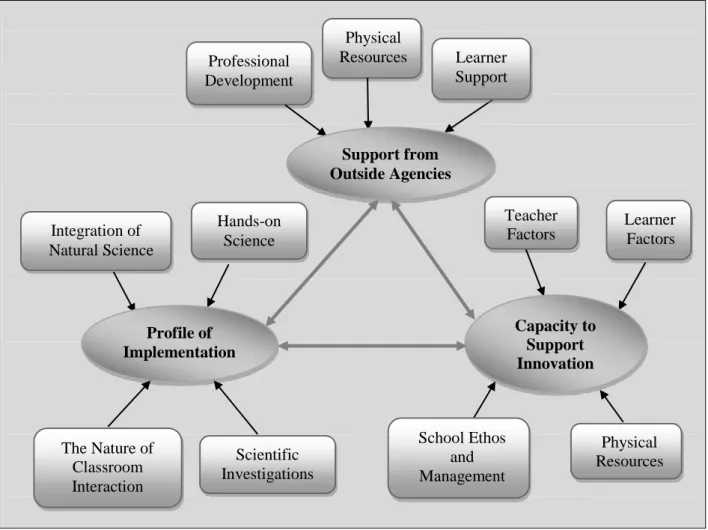
CHAPTER FOUR
RESEARCH METHODOLOGY
INTRODUCTION
CONTEXT AND PARTICIPANTS
It was originally intended that the head of department for the Foundation Phase should be included in the study. Although the school has two heads of department in the foundation phase, neither of them wanted to be part of the study due to their busy schedules. To obtain data, four primary teachers from grades R to three in one school were included in the sample, which was directly related to the purpose of the study.
RESEARCH METHODOLOGY
- Interpretive Paradigm
- A Qualitative Approach
- Case Study Design
- Data Collection Methods and Instruments
Teachers were required to provide biographical data in the questionnaire, as well as a general idea of the teachers' understanding of teaching science at the foundation stage. Embedded in the discussion of the data collection methods is the explanation of how the theoretical framework informed the design of the instruments. The questionnaire provided data on teachers' interpretation of the science curriculum within the Life Skills Learning Program.
NARRATIVE ANALYSIS
DATA COLLECTION AND ANTICIPATED ANALYSIS
- Data Collection
I used the sub-constructs for the profile of implementation and the ability to support innovation to design the schemes for the document analysis of teachers' lesson plans. It also provided data on the sub-construct 'teacher factors', as part of the construct capacity to support innovation. The data from the classroom observations contributed to all sub-constructs of the implementation profile.
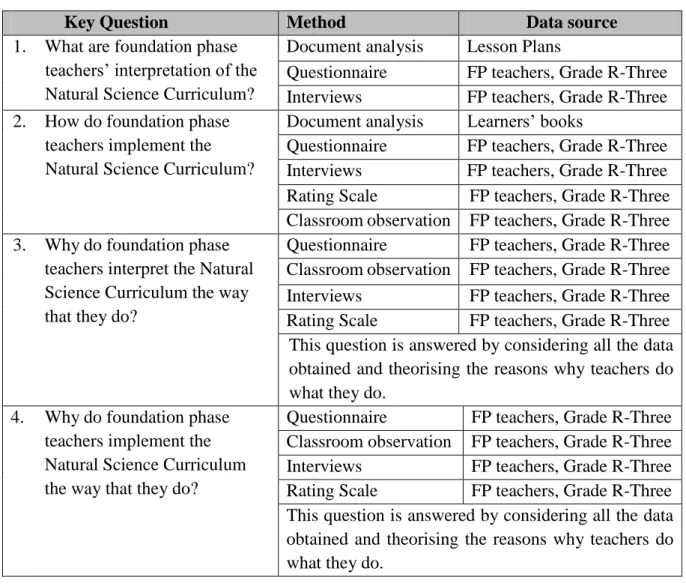
RESEARCH RIGOUR
Reliability is the equivalent expression used in qualitative research as a measure of research quality. Plausibility inspection requires that research data and descriptions be elaborate and rich. The collected data were qualitatively analyzed by organizing and categorizing the data according to the sub-constructs of the theoretical framework.
ETHICAL CONSIDERATIONS
The chronological order of the instruments used was deliberate as each instrument provided a greater depth of information. The principal and the learners were not directly involved in the study as the focus was on the foundation phase teachers. Furthermore, participants were made aware of the fact that they participated in the study voluntarily, and were free to withdraw at any time if they wished.
LIMITATIONS OF THE STUDY
Only after receiving ethical clearances from the university and the Ministry of Education were letters requesting consent given to the principal and four entry-level teachers. In addition, students were given consent letters in English and isiZulu to take home to be signed by their parents or guardians to obtain their informed consent (Appendix J). In this research study, no participants were placed in a situation where they could suffer physical or psychological harm as a result of their participation (Trochim, 2000).
CONCLUSION
I have provided a detailed outline of the research instruments used to obtain the data required for this study, explaining how and where each instrument was used. In chapter five I explain how I undertook the analysis of my data to produce a narrative account of each teacher's interpretation and implementation of the Science curriculum.
CHAPTER FIVE
DATA ANALYSIS AND PRELIMINARY DATA PRESENTATION
INTRODUCTION
INTERPRETATION OF THE NATURAL SCIENCE CURRICULUM
The teaching of Natural Science in the Foundation Phase was considered in relation to each teacher's interpretation of the Natural Science curriculum. I compiled the list of teaching methods that the teachers used to teach Science from the HNKV. The teaching methods that the teachers chose in their lesson plans to teach Natural Science gave insight into their interpretation of the curriculum.
IMPLEMENTATION OF THE NATURAL SCIENCE CURRICULUM
- Support from Outside Agencies
- Capacity to Support Innovation
- Profile of Implementation
I extracted the data for the learner factors from the learners' characteristics section of the questionnaire. I extracted the teacher characteristics in the questionnaire from the HNCV documents as the kind of teacher envisioned by the Department of Education. I obtained the data for the sub-construct of integration of the Natural Science Curriculum in the Life Skills Learning Program from observations, document analysis of lesson plans and learner's books and interviews with the teachers.

SUMMARY OF DATA OBTAINED FROM THE INSTRUMENTS
It was analyzed according to class routine and lesson structure, language of instruction, student attention, questions, use of resources, types of activities and teaching methods, and management of group activities. Evidence of integration of science, practical science and scientific inquiry during classroom observations was also considered. I am ready to learn and use scientific knowledge and skills to plan practical science.
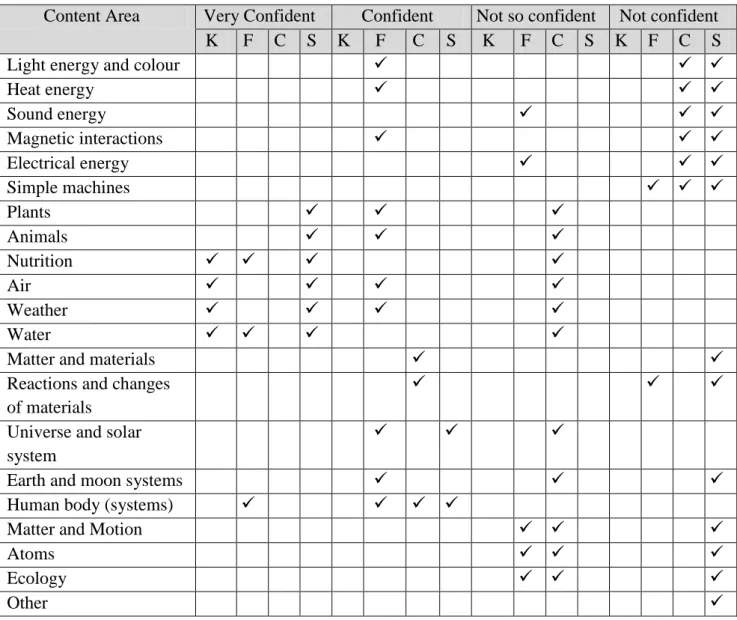
COMPOSITE TABLES OF TEACHERS’ INTERPRETATION AND IMPLEMENTATION
The teacher was aware that science should be taught through integration or as a stand-alone subject, but there was no evidence of this in her lesson plan. The teacher had no knowledge of the science content to be covered in the foundation phase. The teacher was aware that science should be taught through integration or as a stand-alone subject and there was minimal evidence of this in her lesson plan.
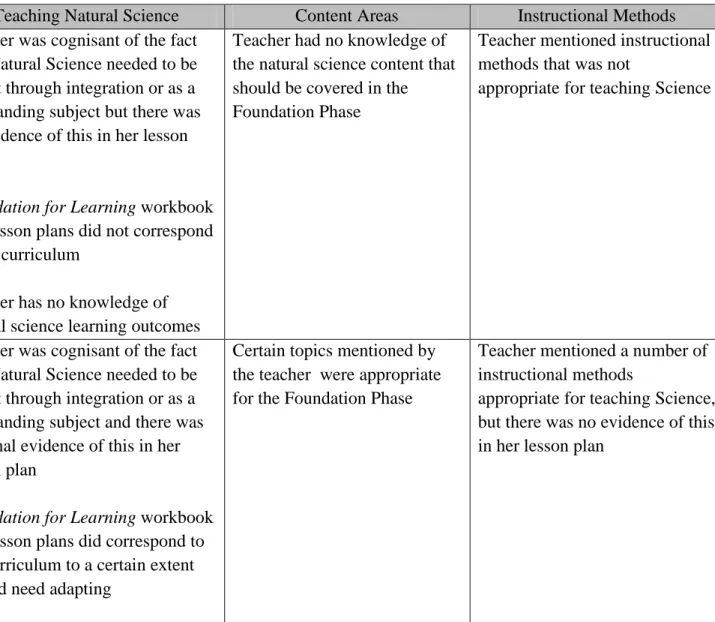
CONCLUSION
CHAPTER SIX
KAREN’S INTERPRETATION AND IMPLEMENTATION OF THE CURRICULUM
INTRODUCTION
KAREN’S STORY
Karen felt that these meetings "were not beneficial." Karen declared, "I'm on the outside." She maintained that she did not normally fit in with the class meetings, but was allowed to attend the meetings that the Department of Education had arranged for Class R. She said: "You got the basics and you were more or less taught to deal with the subject at the primary stage' and "it gave us ideas on how to teach science at the primary stage and we used the ideas from there." Karen didn't mind the noise and mess when children played and experimented when doing Science. The department manager came in and when she was done she went over 'my flaws' and I'm labeled accordingly.” Karen had to schedule Class R on her own; however, the department manager checked the plan.
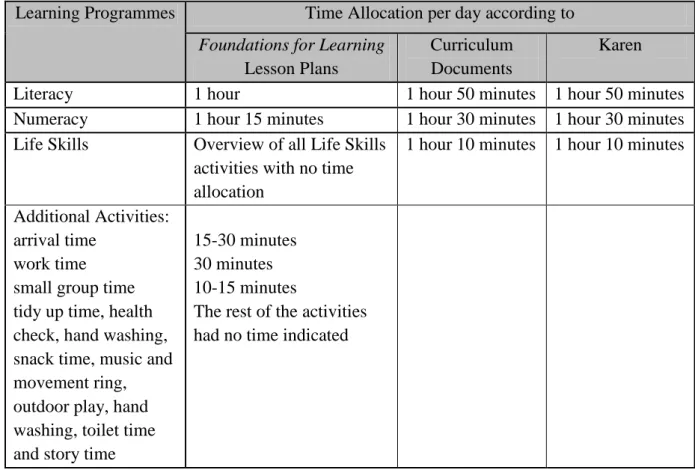
DISCUSSION AND INTERPRETATION
- Interpretation of the Natural Science Curriculum
- Implementation of the Natural Science Curriculum
Karen was unaware of the Science curriculum and was guided by the Foundations for Learning books. Karen's implementation of the Natural Science curriculum is discussed and interpreted using the constructs from the theoretical framework. Karen's confusing responses indicated that her ability to support the implementation of the Science curriculum may be negatively affected.
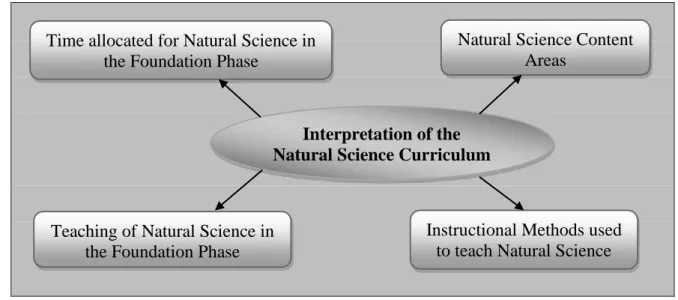
CONCLUSION
